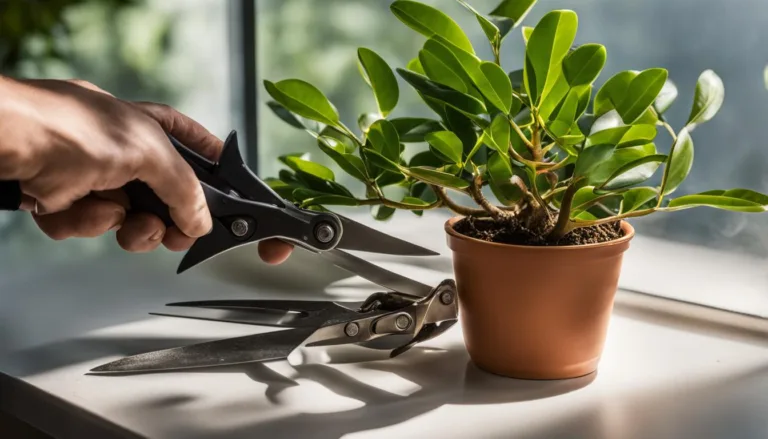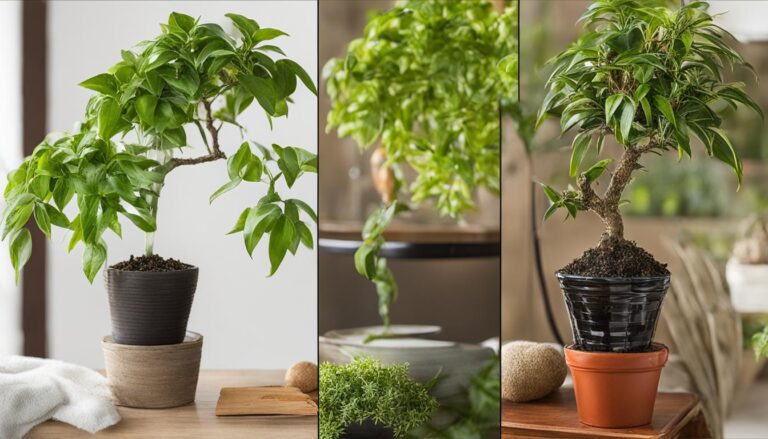
Snake plants, also known as sansevieria or mother-in-law’s tongue, are the perfect low-maintenance plants that are almost impossible to kill. Keep reading to learn how to keep your snake plant healthy and vibrant.
This is the ultimate guide to snake plant care! If you’re a new plant parent or have limited time for plant care, you’re in luck.
Key Takeaways:
- Snake plants are low maintenance and perfect for beginners.
- They require minimal watering and can tolerate various light conditions.
- Snake plants prefer warm temperatures and dry conditions.
- Repotting is only necessary when roots are bursting out of the pot.
- Snake plants can be propagated through division or leaf cuttings.
Introduction to Snake Plants
Snake plants, also known as sansevieria, are succulent plants with long, stiff leaves. Native to southern Africa, these plants have become popular in households all over the world. Snake plants are known for their unique appearance and their ability to thrive in various environments.
With their thick, upright leaves, snake plants are often referred to as mother-in-law’s tongue or tiger’s tail orchids. They come in a variety of shapes, sizes, and patterns, making them a versatile choice for any plant lover. Whether you prefer the classic green and yellow striped leaves or the more modern dark green varieties, there’s a snake plant to suit every taste.
Snake Plant Varieties
| Variety | Description |
|---|---|
| Dracaena trifasciata ‘Hahnii’ | A compact variety with short, broad leaves |
| Dracaena angolensis | Also known as the “bat plant” due to its unique leaf shape |
| Dracaena trifasciata ‘Laurentii’ | Characterized by its striking yellow edges on dark green leaves |
| Dracaena trifasciata ‘Bantel’s Sensation’ | A rare variety with thin, dark green leaves and white vertical stripes |
Each variety has its own special characteristics, so you can choose the one that best fits your personal style and preferences. Snake plants are not only aesthetically pleasing, but they also offer numerous benefits for your indoor environment.
Are Snake Plants Easy to Care For?
Snake plants are incredibly easy to care for, making them a favorite among plant enthusiasts. Whether you’re a beginner or simply have limited time to devote to plant care, snake plants are the perfect choice. Their low maintenance requirements and ability to thrive on neglect make them a hassle-free addition to any home or office.
One of the reasons snake plants are so easy to care for is their minimal watering needs. These plants are drought-tolerant and can survive for extended periods without water. It’s best to water them when the top two inches of soil feel dry, allowing the soil to dry out between waterings to prevent root rot.
This makes them an ideal choice for those who tend to forget to water their plants or are frequently away from home.
In addition to their minimal watering requirements, snake plants are also adaptable to various light conditions. While they prefer bright, indirect light, they can also tolerate low light environments.
It’s important to avoid exposing them to direct sunlight for extended periods as it can damage their leaves. Place your snake plant in a location that receives at least a few hours of indirect sunlight each day.
| Snake Plant Care Tips: |
|---|
| Water when top two inches of soil are dry. |
| Avoid overwatering to prevent root rot. |
| Place in bright, indirect light. |
| Avoid prolonged exposure to direct sunlight. |
| Keep away from cold drafts. |
Another aspect of snake plant care is their temperature preferences. They prefer to be kept in warm spaces with temperatures above 10°C (50°F).
Cold drafts can be detrimental to their health, so it’s important to protect them from low temperatures. Additionally, snake plants prefer dry conditions, so it’s best to avoid placing them in bathrooms or areas with high humidity.
With their low maintenance requirements, snake plants are perfect for those with busy lifestyles or little experience in plant care. By following these simple care tips, you can enjoy the beauty and health benefits of snake plants without the stress and effort that comes with caring for more demanding plants.
Snake Plant Care Summary:
- Minimal watering requirements – water when top two inches of soil are dry.
- Adaptable to various light conditions – prefer bright, indirect light.
- Keep in warm temperatures above 10°C (50°F) and away from cold drafts.
- Avoid placing in high humidity areas, such as bathrooms.
Watering Your Snake Plant
Proper watering is crucial for the health and well-being of your snake plant. While these plants are known for their ability to withstand neglect, it’s important to find the right balance when it comes to watering.
Snake plants prefer to be slightly underwatered rather than overwatered. It’s best to wait until the top two inches of soil feel dry before watering again. Overwatering can lead to root rot and other issues, so be sure to allow the soil to dry out between waterings.
In the winter months, when snake plants enter a period of dormancy, you’ll want to reduce the frequency of watering. During this time, the plant’s growth slows down, and it requires less water. It’s important to adjust your watering schedule to avoid overwatering and the associated problems.
Light Requirements for Snake Plants
When it comes to providing the right amount of light for your snake plant, there are a few key factors to consider. Snake plants are known to be adaptable when it comes to light conditions, but they do have a preference for bright, indirect light.
This means placing your plant near a window where it can receive a few hours of sunlight, but not in direct sunlight for extended periods. Too much direct sunlight can actually harm the leaves of the plant, so it’s best to find a balance.
If you don’t have a window that provides enough light, don’t worry. Snake plants are also able to tolerate lower light conditions, making them a suitable choice for dimmer areas of your home. Just keep in mind that they may not grow as quickly or be as vibrant in low light, so it’s still important to provide them with as much indirect light as possible.
To recap, here are the key points to remember when it comes to the light requirements for snake plants:
- Snake plants prefer bright, indirect light.
- A few hours of indirect sunlight each day is ideal.
- Avoid placing them in direct sunlight for extended periods.
- They can tolerate lower light conditions, but may not grow as quickly.
By ensuring your snake plant receives the right amount of light, you can help it thrive and stay healthy. Remember, finding a balance between light and shade is key to keeping your snake plant happy.
Light Conditions for Snake Plants
| Light Level | Description |
|---|---|
| Bright, Indirect Light | The ideal light condition for snake plants. Place them near a window that receives a few hours of indirect sunlight each day. |
| Low Light | Snake plants can tolerate lower light conditions, making them suitable for dimmer areas of your home. However, growth may be slower in these conditions. |
| Direct Sunlight | Avoid exposing snake plants to direct sunlight for extended periods, as it can damage their leaves. |

Ideal Temperature for Snake Plants
Snake plants are adaptable to a wide range of temperatures, but they thrive best in warm conditions. Ideally, the temperature for snake plants should be above 10°C (50°F). It is important to avoid exposing them to cold drafts or temperatures below 50°F, as this can be detrimental to their health. A consistent and moderate temperature is key to keeping your snake plant happy and thriving.
While snake plants can tolerate a variety of temperatures, they do not do well in high humidity or overly damp environments. It is best to keep them in areas with dry conditions and avoid placing them in bathrooms or rooms with excessive moisture.
Providing adequate ventilation and airflow will help maintain the ideal temperature and prevent the build-up of excessive humidity around your snake plant.
When it comes to temperature, it’s important to strike a balance. Avoid placing your snake plant near heating or cooling vents, as extreme temperature fluctuations can stress the plant. Instead, choose a spot that offers stable and moderate temperatures throughout the year.
With the right temperature conditions, your snake plant will thrive and continue to beautify your space.
The Ideal Temperature Range for Snake Plants
| Temperature | Condition |
|---|---|
| Above 10°C (50°F) to 27°C (80°F) | Ideal temperature range for snake plants |
| Below 10°C (50°F) | Can cause harm to snake plants |
| Above 27°C (80°F) | Can lead to heat stress |
Remember, snake plants are adaptable and can tolerate slight temperature variations. However, it’s always best to provide them with the optimal conditions for growth and overall well-being.
By maintaining the ideal temperature range and avoiding extreme temperature fluctuations, you can ensure that your snake plant remains healthy and thrives in your home or office environment.
Repotting Essentials
Repotting snake plants is not something you’ll need to do frequently, as they are slow growers and prefer to be slightly root-bound. However, there are a few key essentials to keep in mind when the time comes for repotting.
First, assess whether repotting is necessary by checking if the roots are bursting out of the bottom of the current pot. If so, it’s time to give your snake plant a new home.
When repotting, choose a pot that is slightly larger than the current one to allow for future growth. Using a houseplant or cactus compost is recommended, as it provides the right balance of nutrients and drainage. It’s essential to ensure that the chosen pot has good drainage holes to prevent water from pooling and causing root rot.
Once you have your new pot and soil ready, gently remove the snake plant from its current container and loosen the roots. Place the plant in the new pot, making sure it is centered and at a similar depth as before.
Fill the empty spaces with the fresh compost, lightly pressing down to secure the plant. Water the newly repotted snake plant thoroughly and allow any excess water to drain away.
Repotting Essentials
| Essentials | Description |
|---|---|
| Pot Size | Choose a slightly larger pot to accommodate future growth. |
| Soil | Use a houseplant or cactus compost for proper drainage and nutrient balance. |
| Drainage | Ensure the new pot has drainage holes to prevent waterlogging. |
| Repotting Process | Gently remove the plant from its current pot, loosen the roots, and position it in the new pot at a similar depth. |
| Watering | Thoroughly water the plant after repotting and allow excess water to drain away. |
Remember, repotting should ideally be done in the spring when the snake plant is entering its active growth phase. However, if you notice signs of severe root binding or other issues, repotting can be done at any time of the year. Just be sure to follow the repotting essentials mentioned above to give your snake plant the best chance for continued health and growth.
Extra Care for Snake Plants
While snake plants are known for their low-maintenance nature, a little extra care can go a long way in keeping them healthy and thriving. Here are some tips to give your snake plant the TLC it deserves:
1. Wiping the Leaves
Snake plants have broad, sturdy leaves that can accumulate dust and debris over time. To keep them looking their best, gently wipe the leaves with a clean, damp cloth. This not only removes dirt but also helps the plant absorb light more efficiently, ensuring optimum photosynthesis.
2. Fertilizing Occasionally
While snake plants can thrive without regular fertilization, giving them a monthly dose of liquid fertilizer during the spring and summer can provide them with an extra boost of nutrients. However, be careful not to over-fertilize, as this can lead to fertilizer burn and damage the plant. Follow the instructions on the fertilizer package and dilute it accordingly.
3. Regularly Inspecting for Pests
Like any other houseplant, snake plants can be susceptible to pest infestations. Keep an eye out for common pests such as mealybugs, spider mites, and scale insects. Inspect both the leaves and the soil for signs of pests, such as sticky residue, webbing, or small moving insects.
If you notice any pests, treat your snake plant with an appropriate insecticide or try natural remedies like neem oil or a mixture of water and mild dish soap.
4. Protecting from Drafts and Extreme Temperatures
Snake plants prefer temperatures above 10°C (50°F) and are sensitive to cold drafts. Avoid placing them near windows or doors that are frequently opened during colder months.
Extreme temperatures can also negatively affect their health. Keep them away from vents or radiators that may cause excessive heat or cold. Maintaining a stable temperature in the room, ideally between 18-27°C (65-80°F), will help your snake plant thrive.
By following these extra care tips, you can ensure that your snake plant remains healthy, vibrant, and a beautiful addition to your indoor space.
Propagation Techniques
Propagating snake plants is a simple and rewarding process that can be done through division or leaf cuttings. Both methods are effective and can be done in spring or summer to ensure the best chances of success. Let’s explore these propagation techniques in more detail.
Division
Division involves separating a healthy snake plant into smaller sections, each with its own roots. To propagate through division, carefully remove the plant from its pot and gently separate the individual sections, ensuring that each section has a few healthy leaves and a well-developed root system. It’s important to use a sharp, clean knife or gardening shears to avoid damaging the plant.
Once the sections have been separated, you can either plant them directly into pots with well-draining soil or place them in water to develop roots before potting. It’s essential to provide the new divisions with the same care and environmental conditions as mature snake plants to promote healthy growth.
Leaf Cuttings
Snake plants can also be propagated through leaf cuttings. To propagate using this method, select a healthy leaf and use a clean, sharp knife to cut it into smaller sections, each about 2-3 inches long. Make sure that each cutting has a small portion of the base intact, as this is where the new roots will develop.
Once the leaf cuttings have been prepared, you have two options: you can either place them in water to encourage root growth or plant them directly into a well-draining potting mix. If you choose to root the cuttings in water, make sure to change the water regularly to prevent the growth of bacteria and fungi. If you opt for direct planting, bury the cuttings in a potting mix, making sure to leave the top portion exposed.
Regardless of the propagation method you choose, it’s important to provide the new plants with adequate warmth, indirect light, and regular watering to encourage healthy root and foliage development. With proper care, the new snake plants will thrive and grow into beautiful specimens.
Encouraging Snake Plants to Bloom
If you want to see your snake plant bloom, there are a few key factors to consider. Providing optimal light conditions is essential for encouraging flowering. Snake plants prefer bright, indirect light, so place them in a location that receives at least a few hours of sunlight each day. However, be careful not to expose them to direct sunlight for extended periods as it can damage their leaves.
Soil preferences also play a role in promoting blooming. Snake plants thrive in well-draining soil that allows water to flow freely. A mix of potting soil, sand, and perlite is suitable for creating a well-draining environment. Make sure to avoid overwatering, as excess moisture can lead to root rot and hinder blooming.
Watering for flowering is a delicate balance. During the growing season, water your snake plant when the top two inches of soil feel dry. However, as the plant enters a dormant state in winter, reduce watering frequency to simulate its natural conditions. Remember, overwatering can inhibit blooming, so it’s crucial to allow the soil to dry out between waterings.
| Temperature and Humidity Needs | Fertilizer Tips |
|---|---|
| Snake plants prefer temperatures above 10°C (50°F) and should be protected from cold drafts. Exposure to temperatures below 50°F can harm their overall health. | While fertilizing is not necessary for snake plants, applying a liquid fertilizer sparingly during the growing season can provide them with extra nutrients. Fertilize once a month to avoid overfeeding. |
It’s important to note that not all snake plant varieties will bloom. If blooming is a priority for you, choose cultivars that are known to produce flowers. With the right care and attention, your snake plant may surprise you with a beautiful display of blooms. However, remember that snake plants grown as houseplants rarely bloom, so enjoy their lush foliage even if blooming doesn’t occur.

Expert Tip
I recommend placing your snake plant near a window that faces east or west. This will provide the ideal balance of sunlight without exposing the plant to direct rays during the hottest parts of the day. Remember to rotate your snake plant occasionally to ensure even growth and prevent it from leaning towards the light source.
Exploring Snake Plant Varieties
Snake plants are available in a variety of intriguing cultivars, each with its own distinct features and appeal. These unique varieties offer plant enthusiasts a wide range of options to choose from, adding a touch of diversity to their indoor gardens. Let’s take a closer look at some popular snake plant varieties:
Dracaena trifasciata ‘Hahnii’
This compact snake plant variety is also known as the bird’s nest snake plant due to its rosette-shaped foliage. It has short, broad leaves that curl slightly inward, giving it an attractive appearance. This variety is perfect for smaller spaces or as a tabletop plant.
Dracaena angolensis
Also known as the cylindrical snake plant, this variety features long, cylindrical leaves that grow upright. The leaves have a dark green color with light gray-green horizontal stripes, adding visual interest to any space. It’s an excellent choice for those looking for a tall and slender snake plant variety.
Dracaena trifasciata ‘Laurentii’
The ‘Laurentii’ variety is a classic snake plant with a bold and dramatic look. It has broad, sword-shaped leaves with a vibrant yellow margin that contrasts beautifully with the deep green center. This variety is a statement piece that adds a splash of color and elegance to any room.
Dracaena trifasciata ‘Bantel’s Sensation’
This snake plant variety is known for its striking appearance. It has long, slender leaves with dark green vertical stripes against a light green background, creating a visually stunning pattern. ‘Bantel’s Sensation’ is a great choice for those who want a snake plant with a contemporary and eye-catching look.
With these diverse and captivating snake plant varieties, you can find the perfect one to suit your taste and elevate the ambiance of your living space. Whether you prefer compact, tall, colorful, or unique foliage, there’s a snake plant variety out there for everyone. Explore these options and let your indoor garden thrive with the beauty of snake plants.
Pruning Your Snake Plant
When it comes to snake plants, pruning is generally not necessary unless you want to control their height or remove any damaged leaves. If you find that your snake plant is getting too tall, simply grab a pair of clean, sharp scissors or pruning shears and cut off the tallest leaves at the soil line. This will help maintain a more compact shape and keep your plant looking neat and tidy.
As for damaged leaves, if you notice any leaves that are yellowing, brown, or wilted, it’s best to remove them to promote healthier growth. You can use the same scissors or pruning shears to carefully trim off these damaged leaves at the base. Just make sure to sanitize your tools beforehand to prevent the spread of any potential diseases.
Potting and repotting your snake plant is another aspect of care that may require attention. Repotting should only be done when the plant has outgrown its current pot or the roots have become overcrowded.
When it’s time to repot, choose a pot that is slightly larger than the current one to provide room for growth. Opt for a pot with good drainage to prevent overwatering and root rot.
The best time to repot your snake plant is in the spring when it’s actively growing. This allows the plant to recover and establish itself in its new pot more easily. Remember to use well-draining soil specifically formulated for houseplants or cacti to ensure proper moisture levels and proper aeration for the roots.
After reading this, check out our other articles on:
FAQ
Are snake plants easy to care for?
Yes, snake plants are known for their low maintenance and ability to thrive on neglect. They are perfect for beginners or busy individuals who don’t have much time to devote to plant care.
How often should I water my snake plant?
It’s best to water your snake plant when the top two inches of soil feels dry. Overwatering can cause root rot, so it’s important to allow the soil to dry out between waterings.
What light conditions do snake plants prefer?
Snake plants prefer bright, indirect light, but they can also tolerate low light environments. Avoid exposing them to direct sunlight for extended periods as it can damage their leaves.
What is the ideal temperature for snake plants?
Snake plants prefer to be kept in a warm spot with temperatures above 10°C (50°F). Protect them from cold drafts, as exposure to temperatures below 50°F can be detrimental to their health.
How often should I repot my snake plant?
Snake plants are slow growers and don’t require frequent repotting. You can keep them in their original nursery pot for a long time unless the roots are bursting out of the bottom. If repotting is necessary, do it in spring using a houseplant or cactus compost.
How do I take care of my snake plant?
Snake plants are generally low-maintenance, but they can benefit from a little extra care. Wipe the leaves occasionally with a clean, damp cloth to remove dust and debris. During the spring and summer, feed your snake plant with a liquid fertilizer once a month to provide it with extra nutrients. However, fertilizing is not necessary and the plant can thrive without it.
How do I propagate a snake plant?
Snake plants can be propagated through division or leaf cuttings. Division involves separating a healthy plant into smaller sections, each with its own roots. Leaf cuttings can also be used to propagate snake plants. Cut a healthy leaf and either place it in water to develop roots or directly plant it in a potting mix.
How can I encourage my snake plant to bloom?
Snake plants grown as houseplants rarely bloom, but if you want to encourage flowering, provide them with optimal light conditions, well-draining soil, proper watering, and appropriate temperature and humidity levels. Fertilize sparingly during the growing season to provide essential nutrients.
What are some popular snake plant varieties?
Some popular snake plant varieties include Dracaena trifasciata ‘Hahnii’, Dracaena angolensis, Dracaena trifasciata ‘Laurentii’, and Dracaena trifasciata ‘Bantel’s Sensation’. These varieties differ in size, leaf color, and growth habits.
Do I need to prune my snake plant?
Pruning is not necessary for snake plants unless you want to control their height or remove damaged leaves. To control height, simply cut off the tallest leaves at the soil line. Repotting is only necessary when the plant has outgrown its current pot or the roots are overcrowded.







4 Comments